Which mechanical keyboard switch should you use?
Everything you need to work out which mechanical keyboard switch is right for you
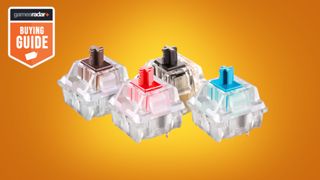
Mechanical keyboards come in all shapes and sizes, but finding out which mechanical keyboard switch is right for you should be at the top of your priority list if you're looking to invest. Whether you're in the market for one of the best gaming keyboards, or building your own custom hot-swappable keyboard there are plenty of colors, numbers, brand names, and model types flying around to confuse matters.
Mechanical keyboard switches are split into three categories first and foremost; linear, tactile, and clicky. Within each of these three groups there are several models (each denoted, generally speaking, by color). Once you've filtered through to the exact switch type you're looking for, there are multiple different brands to consider.
That's why we're helping you find out exactly which mechanical keyboard switch you should be looking at for your next board. You'll find out everything you need to know about the three different mechanical keyboard switch types, and then we're diving into each one individually (or you can skip to the model you want from the menu on the left).
Which mechanical keyboard switch is right for you?

At their highest level, mechanical keyboard switches are categorised according to how they feel and actuate.
Linear switches allow for a unhindered keypress straight down. That means a lighter feeling that won't tire you out after longer periods of typing or gaming and a (generally) faster experience overall.
Tactile switches offer a small bump halfway down the keypress. That makes the feeling of typing a little more satisfying, but can slow down repeat presses and twitch reflex moves when gaming. Typing, however, can be improved as there's no need to bottom out on each keypress.
Clicky switches retain the tactile bump of the model above, but also add an auditory 'click' sound to each press. That's far more satisfying than the smooth freefall of a linear switch, but certainly isn't designed for an office or streaming environment.
Sign up to the GamesRadar+ Newsletter
Weekly digests, tales from the communities you love, and more
Each of the three mechanical keyboard switch types are banded into colors (linear switches will usually be classed as red or black across brands, for example). Once you've decided which switch type you're after, you can filter your search down to the specific model by color below.
This guide will take you through some of the more popular mechanical keyboard switch brands; Cherry, Gateron, Kailh, and Outemu. However, there are plenty more out there as well, and keyboard manufacturers themselves will often use their own proprietary switches to boot - just check out the clickers available in the best Razer keyboards.
| Brand | Linear | Tactile | Clicky Tactile |
|---|---|---|---|
| Cherry | Red / Black / White / Speed Silver | Brown / Clear / Gray | Blue / Green / |
| Gateron | Red / Black / Clear / Yellow | Brown | Blue / Green |
| Kailh | Red / Black / Speed Silver | Brown / Speed Copper | Blue / Speed Bronze / Green |
| Outemu | Red / Black | Brown | Blue |
Linear mechanical keyboard switches
Linear mechanical keyboard switches allow a keypress to go straight down through the point of actuation. That means there's no 'bump' to fully depressing this key, making them considerably quieter than tactile options. Because the key doesn't need to physically move back over that bump in order to register a repeat press, linear switches are also considered better for speed, whether you're typing or gaming.
In general, linear mechanical keyboard switches will be signalled by their red or brown colors, but you'll also find white, silver, and yellow models on the market as well.
Red linear switches
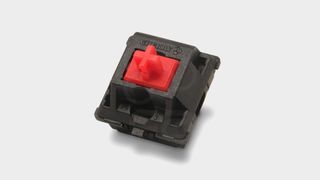
The red linear mechanical keyboard switch is one of (if not the) most popular options on the market right now. It's the defacto switch used in many gaming keyboards with a standard 2mm down to the actuation point and 4mm total travel. Relatively lightweight, this is the go-to for many gamers and typists alike.
Average actuation force on a red linear switch is 45cN, which is considerably lighter than that of the black model. That means these switches are easier to use for sustained periods of time (good news for work), and can trigger on twitch reflexes and repeat presses faster (good news for play). However, a lesser actuation force means more chance of an accidental keypress, though that risk doesn't loom as large as it does with the silver model.
Many red linear mechanical keyboard switches are direct clones of the Cherry MX Red, which means you'll find 2mm / 4mm travel distances across the board. However, different brands build different levels of resistance into their springs, which makes for varied actuation forces.
| Header Cell - Column 0 | Cherry MX Red | Gateron Red | Kailh Red | Outemu Red |
|---|---|---|---|---|
| Actuation force | 45cN | 45cN | 50cN | 50cN |
| Actuation point | 2mm | 2mm | 2mm | 2mm |
| Total travel | 4mm | 4mm | 4mm | 4mm |
- Cherry MX Red | From $10 at Amazon
- Gateron Red | $39.99 at Amazon
- Kailh Red | $42.99 at Amazon
- Outemu Red | $11.99 at Amazon
Black linear switches
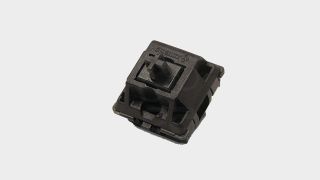
You're getting a hard, heavy spring in a black linear switch here with an actuation force reaching 60cN. That's a little too much effort for typists, but if you're worried about accidental keypresses and you want a strong resistance behind each tap, you'll find a sturdy little switch in the linear black model. These mechanical keyboard switches keep the smooth linear feel of the reds, but add extra weight to each keypress.
The switch housing itself is, obviously, black though - which can mean any RGB LEDs will be blocked out. That, combined with the heavier keypress, means this is a switch geared more towards typists looking for a satisfying thud which each hard-won word.
| Header Cell - Column 0 | Cherry MX Black | Gateron Black | Kailh Black | Outemu Black |
|---|---|---|---|---|
| Actuation force | 60cN | 50cN | 60cN | 65cN |
| Actuation point | 2mm | 2mm | 2mm | 2.6mm |
| Total travel | 4mm | 4mm | 4mm | 4mm |
- Cherry MX Black | $49.99 at Amazon
- Gateron Black | $29.99 at Amazon
- Kailh Black | $34.99 at Amazon
- Outemu Black | $13.99 at Amazon
Silver linear switches

Specifications do vary, but silver switches are generally super fast. Different brands play with different combinations of actuation forces and actuation points to make for a speedy trigger. For example, the slightly heavier 45cN force required for a Cherry MX Silver is counter-balanced by a shorter 1.4mm actuation point. That means you're pressing a little harder than you would in the Gateron Clear, but reaching that point of actuation a little sooner into the keypress.
Silver linear mechanical switches are built for those looking for twitch reflex response in fast paced action games.
If you're worried about accidental keypresses, we'd recommend aiming for a heavier actuation force. However, the smaller both of these numbers are, the more sensitive your switch is going to be.
| Header Cell - Column 0 | Cherry MX Silver | Gateron Clear | Kailh Speed Silver |
|---|---|---|---|
| Actuation force | 45cN | 35cN | 50cN |
| Actuation point | 1.4mm | 2mm | 1.1mm |
| Total travel | 3.4mm | 4mm | 3.5mm |
- Cherry MX Silver | $59.99 at Amazon
- Gateron Clear | $29.99 at Amazon
- Kailh Speed Silver | $39.99 at Amazon
Tactile mechanical keyboard switches
There are fewer tactile mechanical keyboard switches on the market than there are linear or clicky models. While a little harder to find, though, these switches are perfect for typists looking for a more satisfying actuation without the annoying sounds that could come from a clicky switch (your colleagues will thank you). There's a 'tactile' bump just before actuation in these switches, rather than the freefall of a linear. Once you're used to the feel of them, this bump makes typing far quicker as the user can feel the actuation point without having to fully bottom out the switch.
Once mastered, tactile switches can lead to particularly speedy typing. However, that bump design does mean repeat keypresses are a little more difficult to accomplish with the speed of a linear model.
Brown switches are, by far, the most popular tactile switches. However, some brands do offer other models with focus on faster actuation and shorter travel time.
Brown tactile switches
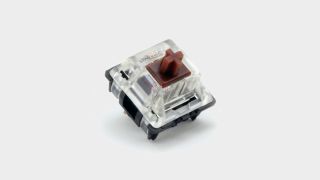
Brown mechanical keyboard switches are very similar to red linear models. They typically stick to an actuation point at around 2mm and a full travel distance of 4mm. However, the addition of that tactile bump does mean they require a little more actuation force to register each keypress.
That bump does make itself known in different ways across brands. Cherry, for example, is known for having a very small bump - almost unnoticeable if you're not paying attention to it. However, Halo Clears place a great emphasis on that tactile nature with a far longer bump and reduced tension in the spring below each actuation point.
The bump design also allows some switches, like the Kailh Speed Copper, to bring the actuation point further up the keypress. That allows for a faster trigger to compensate for a slightly higher actuation force.
| Header Cell - Column 0 | Cherry MX Brown | Gateron Brown | Kailh Brown | Kailh Speed Copper | Outemu Brown |
|---|---|---|---|---|---|
| Actuation force | 55cN | 45cN | 45cN | 50cN | 55cN |
| Actuation point | 2mm | 2mm | 2mm | 1.1mm | 2mm |
| Total travel | 4mm | 4mm | 4mm | 3.5mm | 4mm |
- Cherry MX Brown | $14.99 at Amazon
- Gateron Brown | $25 at Amazon
- Kailh Brown | $34.99 at Amazon
- Kailh Speed Copper | $39.99 at Amazon
- Outemu Brown | $24.99 at Amazon
Clicky mechanical keyboard switches
A clicky mechanical keyboard switch is either your best friend or your worst enemy. These louder switches split opinion regularly. Their fans love them for their feedback, satisfying tap sound, and crisp feel - they're the antithesis of everything you may have come to hate about mushy membrane keyboards. Their critics (or those working anywhere near the fans) will take issue with the incredibly loud noise that they can produce.
That tactile bump is also far more pronounced on these switches, which means typists have an easier time of working without having to bottom out the switch - increasing their speed in the meantime. For all the fun they represent, though, clicky switches generally aren't geared towards gaming. That pronounced bump makes it hard to trigger repeated presses quickly, and the louder noise can bleed straight into your team chat as well.
Blue clicky switches
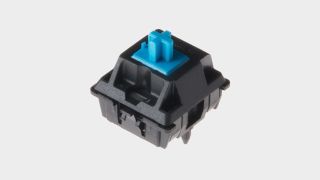
The blue switch is the default clicky model, with a crisp sound and bags of feedback with every press. Actuation points around that tactile bump will differ between brands, but the lower the position the more sensitive your switch will be to twitch reflexes.
Blue switches offer a light enough actuation force that you won't need to place too much emphasis on each key, which - combined with the highly tactile bump - means you'll be able to actuate without bottoming out much easier. That makes these switches perfect for speedy typists and programmers.
| Header Cell - Column 0 | Cherry MX Blue | Gateron Blue | Kailh Blue | Outemu Blue |
|---|---|---|---|---|
| Actuation force | 60cN | 55cN | 50cN | 60cN |
| Actuation point | 2.2mm | 2.3mm | 2mm | 2.7mm |
| Total travel | 4mm | 4mm | 4mm | 3.6mm |
- Cherry MX Blue | $14.99 at Amazon
- Gateron Blue | $29.99 at Amazon
- Kailh Blue | $44 at Amazon
- Outemu Blue | $9.99 at Amazon
Green clicky switches

You won't find as much conversation around green switches, but they're a well-known heavier alternative to the blues mentioned above. Many brands replicate the same stems between their blue and green models (which means you'll see similar actuation and travel distances). However, this model is much heavier and often offers a slightly bassier sound compared to the crisp audio profile of blues.
| Header Cell - Column 0 | Cherry MX Green | Gateron Green | Kailh Green |
|---|---|---|---|
| Actuation force | 80cN | 80cN | 60cN |
| Actuation point | 2.2mm | 2mm | 1.8mm |
| Total travel | 4mm | 4mm | 3.6mm |
- Cherry MX Green | $15.99 at Amazon
- Gateron Green | $29.99 at Amazon
- Kailh Green | $45.99 at Amazon
We're also rounding up all the best gaming mouse options on the market so that you can complete your dream setup. Or, take a look at the best gaming headsets and the best gaming monitors for a full refresh.

Managing Editor of Hardware at GamesRadar+, I originally landed in hardware at our sister site TechRadar before moving over to GamesRadar. In between, I've written for Tom’s Guide, Wireframe, The Indie Game Website and That Video Game Blog, covering everything from the PS5 launch to the Apple Pencil. Now, i'm focused on Nintendo Switch, gaming laptops (and the keyboards, headsets and mice that come with them), PS5, and trying to find the perfect projector.
Most Popular



